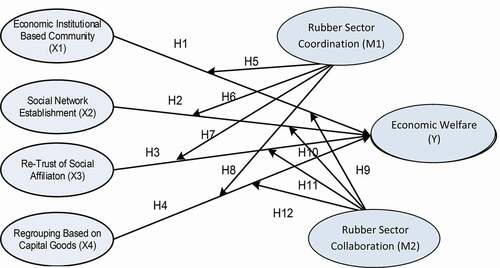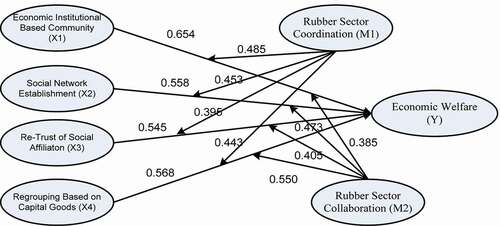Abstract
The purpose of this paper is to determine the effect of the Economic Institutional Based Community, Social Network Establishment, Re-trust of Social Affiliates, and Regrouping Based on Capital Goods on Economic Welfare through the Moderation of Rubber Sector Coordination, and Collaboration on the Rubber Sector. This research utilized qualitative explanatory associative. The study was conducted on the rubber plantation community in Kuantan Singingi Regency, Riau Province, Indonesia. The research approach used was quantitative with an analysis tool Generalized Structure Component Analysis (GSCA). The results of the analysis, there is an influence of the Economic Institutional Based Community, Social Network Establishment, Re-trust of Social Affiliates, and Regrouping Based on Capital Goods and Rubber Sector Coordination and Collaboration Rubber Sector on Economic Welfare. The higher value of the Economic Institutional Based Community, Social Network Establishment, Re-trust of Social Affiliates, and Regrouping Based on Capital Goods and Rubber Sector Coordination and Collaboration on the Rubber Sector will have an impact on the increasing economic welfare. In addition, it was also found that the Rubber Sector Coordination and Collaboration moderated the influence of the Economic Institutional Based Community variable, Social Network Establishment, Re-trust of Social Affiliates, and quasi Regrouping Based on Capital Goods moderator and enrichment. The existence of a moderating effect in this study is a distinction between this research and previous studies. Previous research merely described the problem qualitatively. Similar research has never been carried out in the Kuantan Singingi area.
PUBLIC INTEREST STATEMENT
Indonesia is an agricultural country because most of its population has a livelihood in the agricultural sector, one of which is in the production of rubber. Riau is one of the provinces in Indonesia that has the largest rubber production. However, over time, rubber production in Riau Province has stagnated. This is partly due to the lack of empowerment of human resources, especially in small and medium social groups. Therefore, in this study, the development of small and medium-scale socio-economic groups in rubber plantations is the main target that in turn will provide opportunities for the development of economic activities.
1. Introduction
Rubber production in Riau Province is one of the largest in Sumatra. In the period 2008 to 2012, rubber production in Riau Province experienced stagnancy. The production rate was in the range of 325,000 tons to 396,000 tons in 500,949 hectares of land use (Statistics, Citation2013). Based on land use, the highest rubber commodity development potency is in Kuantan Singingi Regency possessing an area of 146,215 hectares. The second largest is Kampar Regency with an area of 101,597 hectares, and Indragiri Hulu Regency with an area of 61,372 hectares (Statistics, Citation2013).
Furthermore, the rubber plantations’ stagnant productivity is counterproductive to macro development scenarios compiled at both the central and regional levels. Master Plan for the Acceleration of Indonesian Economic Development (MP3EI) explicitly stated that there is a need for accelerated economic development in Sumatra through the rubber industry development. The output is to build\ a downstream industry for rubber commodities, which will eventually bring multiplier effects in other fields, especially the community economy.
The urgency to revitalize rubber commodities in Kuantan Singingi Regency increased when people who had been concerned about managing rubber plantations eventually moved to palm oil management as it is considered more profitable in the short/medium term. The decline in the community interest to manage rubber indicates a decline in the level of pull and push factors in rubber commodities development in the Kuantan Singingi Regency. Hence, the solution to this issue needs to be immediately sought.
Human resources on rubber commodities management in Kuantan Singingi Regency is concentrated in self-management management patterns. The self-reliant (Swadaya) pattern tends to position the farmer as subordinate. For example, in terms of the rubber selling price. The other four patterns have more bargain and bargaining power in the context of managing rubber commodities, as these patterns move their business in more managerial and systematic ways compared to self-reliant patterns. For example, with the awareness to form an institution. The latest data exhibited that out of 62,975 farmers, 35 rubber plantation business institutions have been formed with a total membership of around 1,012. There are a huge number of farmers managing rubber plantations. Nevertheless, these have not been developed and/or empowered according to their strengths.
The development of small and medium scale socio-economic groups on rubber plantations needs to be the main target in community-based development activities. Such community development will, in turn, provide opportunities for the development of local economic activities and other productive endeavors (Nasdian, Citation2014). Nasdian further argued that institutional development is crucial for the development of productive economic efforts as this development requires high transaction costs. Also, through institutional development, especially customary institutions, it was found to be able to overcome various social problems, such as child neglect and poverty (Hikmat, Citation2006)
The development of rubber plantation institutions reflects the extent to which social networks have been built into these communities. When these two aspects (institutions and social networks) are synergized with various stakeholders functions of the rubber plantation business, will manifest into the development of social capital. Sujianto’s (Citation2008) study exhibited that social capital can provide community development and empowerment on the economic and social aspects through existing social networks. It cannot be denied that community development based on social capital can create a prosperous and empowered society (NurhNurhadi, Citation2008). The challenge is how to develop and utilize social capital. Identifying whether social capital possesses potency or not is important because it can not only support the ongoing development process but may weaken the development process itself (Adi, Citation2008).
Based on the description, a study was conducted which aims to determine the effect of the Economic Institutional Based Community (X1), Social Network Establishment (X2), Re-trust of Social Affiliates (X3), and Regrouping Based on Capital Goods (X4) on Economic Welfare (Y) through the Moderation of Rubber Sector Coordination (M1), and Collaboration on the Rubber Sector (M2). The existence of a moderating effect in this study is a distinction between this research and previous studies. Previous research merely described the problem qualitatively. Similar research has never been carried out in the Kuantan Singingi area, therefore this research is worthy of publication due to its originality.
2. Literature review and conseptual framework
Nasdian (Citation2014) stated that universities, NGOs, and other stakeholders could participate through institutional relations and social networking approaches in an endeavor to develop social groups. The network was formed for socio-economic group development by synergizing the functions of various stakeholders as a form of social capital development. Also, institutional development is crucial in the development of productive economic enterprises as it requires a high transaction cost. According to Nasdian, the development of small and medium-scale socio-economic groups needs to be the main target in community-based development activities. Through the development of such groups, it is hoped that it will be able to reduce unemployment, increase people’s purchasing power, and in turn be able to have a dual impact, especially providing opportunities to develop local economic activities and productive efforts at the community level.
The development of social institutions is an alternative that could be developed with a collaborative institutional network approach from the community level to the locality level, exhibiting that the implementation of equality principles is more informal, participatory, has a strong commitment, and synergizes existing strengths. It is very helpful in solving problems and finding solutions in efforts to develop productive businesses at the community level.
The development of rubber plantation institutions reflects the extent to which social networks have been built into these communities. Should institutions and social networks aspects are synergized with the functions of various stakeholders of the rubber plantation business, will manifest into the development of social capital. Sujianto’s (Citation2008) study exhibited that social capital can provide community development and empowerment on the economic and social side through existing social networks.
The theory of social capital was originally developed by French sociologist Pierre Bourdieu, and by US sociologist James Coleman. Bourdieu states that there are three types of capital, namely money capital, social capital, and cultural capital. These three capitals would be more effectively used when there are social interactions or social relations. Social capital can be used for all purposes, but without physical resources and cultural knowledge, it will be difficult for individuals to build a social relationship. Social relations will be strong if the three elements above exist (Coleman, Citation1988). James Coleman defines social capital as a structure of relationships between individuals that enables them to create new values. According to Coleman, social capital is weak by processes that destroy kinships, such as divorce and separation, or migration. When families leave their existing kinship networks, friends, and other contacts, the value of their social capital will fall (Field, Citation2005, p. 140).
Social Capital is a resource seen as an investment to obtain new resources. The resources used for investment are called capital. Social capital is extensive and complex. Social capital is not interpreted based on material, but as a capital contained within someone. For example, in groups of family institutions, organizations, and all manners that lead to cooperation. Social capital places more emphasis on the potential of groups and relationship patterns between individuals in a group and between groups, with attention to beliefs, networks, norms, and values born from group members and become group norms.
Social affiliation thus refers to behaviors, such as the reduction in the physical distance from others, postural orientation towards others, looks at others, and any verbal or non-verbal behaviors (facial expressions, gestures) that initiate or maintain visual, physical, and/or verbal contact with another (see Delelis, Citation2002; Cottrell & Epley, Citation1977; Kulik & Mahler, Citation2000). The notion that social affiliation may be involved in emotion regulation appeared in Schachter’s seminal work (Schachter, Citation1959) on the motives of social affiliation in anxiety-producing situations. What remains unclear is how, and under what conditions social affiliation contributes to emotion regulation.
Economic welfare is economic wellbeing expressed in terms of the sum of consumer and producer surplus—also known as community surplus. The concept of a welfare economy was coined by the famous economist Arthur Cecil Pigou in his work ’Economics of Welfare.’ Welfare economics is a branch of economics that evaluates the distribution of goods and resources, the structure of markets and guides the making of public policies for the betterment of society. This theory is directly related to the distribution of income, economic efficiency, and the relation of these aspects with the well-being of society. The concept of welfare economics is a subjective study based on the assumption of how society and individuals in it can be benefitted or, in other words, how assumptions regarding policies can be constructed efficiently such that they can benefit the overall society. Famous economists who professed this theory are Vilfredo Pareto and Arthur Cecil Pigou.
Based on the definitions given by experts on social capital which broadly exhibited that social capital is an element crucial for the establishment of cooperation between individuals or groups or the establishment of collective cooperative behavior. Social capital is inseparable from the three main elements that exist in social capital which are used as elements of assessment on each type of social capital including (a) Trust (honesty, fairness, egalitarian attitude, tolerance, and generosity); (b) Social Networks (participation, reciprocity, solidarity, cooperation); (c) Norms (shared values, norms and sanctions, rules). The three elements of social capital above and its aspects are essential elements that exist or should exist in the life of a social group, whether the group is called community, ethnic group, and so on. In other words, social capital elements are necessary to run social structure engine well.
3. Material and method
Based on the research problems, this research utilized qualitative explanatory associative. It endeavored to explain causality relationships between exogenous and endogenous variables. The study was conducted on the rubber plantation community in Kuantan Singingi Regency, Riau Province. The sampling technique used in this study was non-probability sampling. Purposive sampling is a sampling method based on certain criteria. Researchers obtained a sample of 90 respondents. The research approach used was quantitative with an analysis tool Generalized Structure Component Analysis (GSCA) (Solimun, Citation2012).
Research Models without Moderation (Hypothesis 1–2)
Y = γ1 X1 + γ2 X2+ γ3 X3 + ε1
Models By Engaging Moderation (Hypothesis 3–5)
Y = γ1X1 + γ2X2 + γ3X3 + γ3M1 + γ4M2 + γ5X1*M1 + γ6X2*M1 + γ7X3*M1 + γ8X1*M2 + γ9X2*M2 + γ10X3*M2 + ε1
Description .
Y = Economic Welfare
M1 = Rubber Sector Coordination
M2 = Rubber Sector Collaboration
X1 = Economic Institutional Based Community
X2 = Social Network Establishment
X3 = Re-Trust of Social Affiliation
X4 = Regrouping Based on Capital Goods
4. Analysis result
4.1. Measurement model
The following table presents each indicators’ average values and outer loading in each research variable.
Based on , the results exhibited that all indicators significantly measure their respective variables. Analysis result exhibited that the most significant indicator of Institutional Based Community (X1) is indicator X1.3 with a loading factor of 0.716 and an average of 4.23. Social Network Establishment Variable (X2) exhibited that the most significant indicator is X2.2 with a loading value of 0.751 and an average of 4.24. Re-trust of Social Affiliation (X3), the X3.1 indicator has a higher loading value compared to X3.2 indicator, therefore, X3.1 indicator is the dominant indicator measuring the variable Re-trust of Social Affiliation (X3). Indicator X4.1 is the most significant indicator measuring Regrouping Based on Capital Goods (X4) with a loading value of 0.557. Rubber Sector Coordination Variable (M1) it is known that the strongest indicator is M1.4 with a loading value of 0.707. Collaborative Variables in the Rubber Sector (M2) exhibit the most significant indicator is M2.5 with a loading value of 0.715. Economic Welfare Variable (Y) exhibit the most significant indicator Y1.4 with a loading value of 0.637 and an average of 4.26.
Table 1. Indicator average and outer loading values
4.2. Analysis result: GSCA
5. Assessing of linearity assumptions
Based on GSCA analysis, there is one assumption that must be fulfilled before an analysis is carried out, namely the linearity assumption, which requires a relationship between variables that are linear. The linearity assumption using the Curve Fit method is the relationship between variables declared linear when it meets one of the following two possibilities: (1) a linear model is significant (linear model sig <0.05), (2) a non-significant linear model and all possible non-significant models (sig linear model >0.05, and sig models other than linear >0.05). The assessment result exhibited the value of the linear model, which is <0.05, therefore, the model is linear and meet the assumptions set.
6. Goodness of fit
Based on the results of the structural feasibility assessment models measured using FIT and AFIT, FIT values of 0.871 and AFIT values of 0.795 were obtained. The FIT value indicated that the total diversity explained by the model is 87.1%. It indicates the formed model can explain all existing variables at 871.1%. The variables variety: Institutional Based Community, Social Network Establishment, Re-trust of Social Affiliates, Regrouping Based on Capital Goods, Rubber Sector Coordination, Rubber Sector Collaboration, and Economic Welfare can be explained by the model at 87.1%, and the remaining 12.9% can be explained by variables others outside the model.
The overall feasibility of the model was measured using GFI and SRMR, GFI values of 0.941 and SRMR values of 0.031 were obtained. The GFI value is greater than 0.900 and the SRMS value is less than 0.08. It indicates that the model used is a good fit.
7. GSCA Analysis
Inner model (structural model) test assessed the research hypothesis. Hypothesis assessment was conducted using t-test (T-statistic) on each direct influence path in the partial method. GSCA and hypothesis assessment result is exhibited in the following
Table 2. The structural model of GSCA results: direct effects
The table is presented in the following figure:
Based on and , the inner model test results can be presented as follows:
Assessing the direct effect of Economic Institutional Based Community (X1) on Economic Welfare (Y), obtained a structural coefficient of 0.645, with a p-value of 0.000 < 0.05, it indicated a significant direct effect between Economic Institutional Based Community (X1) towards Economic Welfare (Y). The structural coefficient is positive, indicating that the relationship is positive. The higher the Institutional Based Community (X1), the higher the Economic Welfare will be (Y).
Assessing the direct effect of Social Network Establishment (X2) on Economic Welfare (Y), obtained a structural coefficient of 0.558, with a p-value of 0.000. Because the p-value is <0.05, there is a significant direct effect between Social Network Establishment (X2) on Economic Welfare (Y). The structural coefficient is positive, indicating that the relationship is positive. the higher the value of the Social Network Establishment (X2), the higher the economic welfare will be (Y).
Assessing the direct effect of Re-trust of Social Affiliation (X3) on Economic Welfare (Y), obtained a structural coefficient of 0.545, with a p-value of 0.000 < 0.05, then there is a significant direct effect between Re-trust of Social Affiliation (X3) against Economic Welfare (Y). The structural coefficient is positive, indicating that the relationship is positive. the higher the Re-trust of Social Affiliation (X3), the higher the Economic Welfare will be (Y).
Assessing the direct effect of Regrouping Based on Capital Goods (X4) on Economic Welfare (Y), obtained a structural coefficient of 0.568, with a p-value of 0.000. Because the p-value <0.05, there is a significant direct effect between Regrouping Based on Capital Goods (X4) on Economic Welfare (Y). The structural coefficient is positive, indicating that the relationship is positive. the higher the value of the Regrouping Based on Capital Goods (X4), the higher the economic welfare will be (Y).
Assessing the direct effect of Rubber Sector Coordination (M1) on Economic Welfare (Y), obtained a structural coefficient of 0.489, with a p-value of 0.000. Because the p-value is <0.05, there is a significant direct effect between Rubber Sector Coordination (M1) on Economic Welfare (Y). The structural coefficient is positive, indicating that the relationship is positive. the higher the Rubber Sector Coordination (M1), the higher the Economic Welfare will be (Y).
Assessing the direct effect of the Rubber Sector Collaboration (M2) on Economic Welfare (Y), obtained a structural coefficient of 0.379, with a p-value of 0.000. Because the p-value is <0.05, there is a significant direct effect between the Rubber Sector Collaboration (M2) on Economic Welfare (Y). The structural coefficient is positive, indicating that the relationship is positive. the higher the Rubber Sector Collaboration (M2), the higher the Economic Welfare will be (Y).
Figure 3. Effects of moderation in the rubber sector coordination on the effects of economic institutional based community on economic welfare
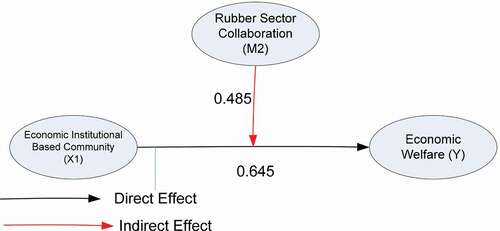
GSCA analysis result obtained an interaction coefficient of 0.485 and P of 0.000. P-value <0.05 indicates that Rubber Sector Coordination is a moderator variable between the influence of Institutional Based Community (X1) on Economic Welfare (Y). The direct influence and the effect of interaction are equally significant for company performance (Y), the Rubber Sector Coordination variable is a quasi-moderator. The coefficient of interaction influence is positive, the Rubber Sector Coordination (M) variable is reinforcing. Higher Rubber Sector Coordination (M), increases the influence of Institutional Based Community (X1) on Economic Welfare (Y). .
Figure 4. Effects of moderation in the rubber sector coordination on the effects of the social network establishment on economic welfare
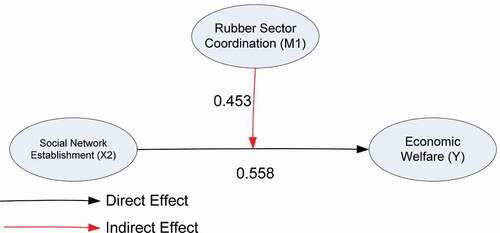
GSCA analysis obtained an interaction coefficient of 0.453 and P of 0.000. P < 0.05 indicates that Rubber Sector Coordination is a moderator variable between the influence of Social Network Establishment (X2) on Economic Welfare (Y). Because the direct influence and the effect of interaction are equally significant for Company Performance (Y), the Rubber Sector Coordination variable is a quasi-moderator. While the coefficient of interaction influence is positive, the Rubber Sector Coordination (M) variable is reinforcing. A higher value of the Rubber Sector Coordination (M), increases the influence of the Social Network Establishment (X2) on Economic Welfare (Y). .
Figure 5. The moderating effect of the rubber sector coordination on the effect of re-trust of social affiliation on economic welfare
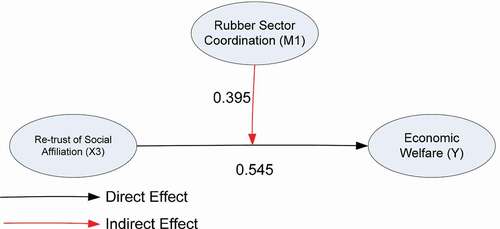
GSCA analysis obtained an interaction coefficient of 0.395 and P of 0.001. P < 0.05 indicates that Rubber Sector Coordination is a moderator variable between the influence of Re-trust of Social Affiliation (X3) on Economic Welfare (Y). Because the direct influence and the effect of interaction are equally significant for company performance (Y), the Rubber Sector Coordination variable is a quasi-moderator. While the coefficient of interaction influence is positive, the Rubber Sector Coordination (M) variable is reinforcing. The higher the value of the Rubber Sector Coordination (M), increases the influence of Re-trust of Social Affiliation (X3) on Economic Welfare (Y). .
Figure 6. Effect of moderation in the coordination of the rubber sector on the effects of regrouping based on capital goods on economic welfare
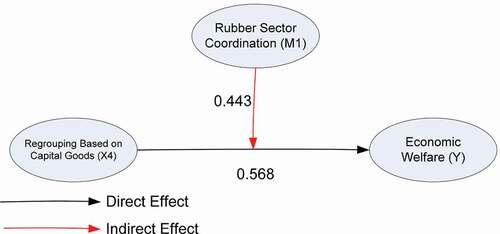
GSCA analysis obtained an interaction coefficient of 0.443 and P of 0.000. P < 0.05 indicates that Rubber Sector Coordination is a moderator variable between the effect of Regrouping Based on Capital Goods (X4) on Economic Welfare (Y). Because the direct influence and the effect of interaction are equally significant for company performance (Y), the Rubber Sector Coordination variable is a quasi-moderator. The coefficient of interaction influence is positive, indicates that the Rubber Sector Coordination (M) variable is reinforcing. Higher Rubber Sector Coordination (M), increases the influence of Regrouping Based on Capital Goods (X4) on Economic Welfare (Y). .
Figure 7. Effects of moderation in the rubber sector collaboration on the effects of economic institutional based community on economic welfare
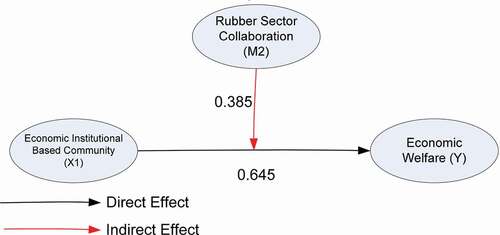
GSCA analysis obtained an interaction coefficient of 0.385 and P of 0.001. P < 0.05 indicates that the Rubber Sector Collaboration is a moderator variable between the influence of Institutional Based Community (X1) on Economic Welfare (Y). Because the direct influence and the effect of interaction are equally significant for company performance (Y), the Rubber Sector Collaboration variable is a quasi-moderator. While the coefficient of interaction effect is positive; hence, the Collaborative Rubber Sector (M) variable is reinforcing. A higher value of the Rubber Sector Collaboration (M), increases the influence of Institutional Based Community (X1) on Economic Welfare (Y). .
Figure 8. Effects of moderation in the rubber sector collaboration on the effects of the social network establishment on economic welfare
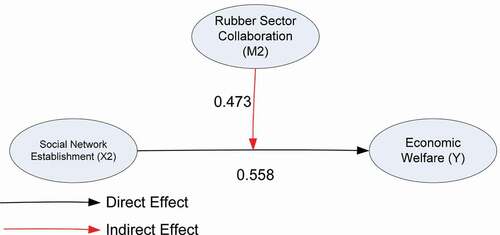
GSCA analysis obtained an interaction coefficient of 0.473 and P of 0.000. P < 0.05 indicates that the Rubber Sector Collaboration is a moderator variable between the influence of Social Network Establishment (X2) on Economic Welfare (Y). Because the direct influence and the effect of interaction are equally significant for company performance (Y), the Rubber Sector Collaboration variable is a quasi-moderator. While the coefficient of interaction effect is positive, the Collaborative Rubber Sector (M) variable is reinforcing. Higher Rubber Sector Collaboration (M), increases the influence of the Social Network Establishment (X2) on Economic Welfare (Y). .
Figure 9. The effect of moderation in the rubber sector collaboration on the effects of re-trust of social affiliation on economic welfare
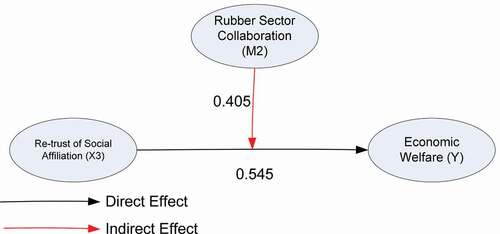
GSCA analysis obtained an interaction coefficient of 0.405 and P of 0.000. P < 0.05 indicates that the Rubber Sector Collaboration is a moderator variable between the influence of Re-trust of Social Affiliation (X3) on Economic Welfare (Y). Because the direct influence and the effect of interaction are equally significant for company performance (Y), the Rubber Sector Collaboration variable is a quasi-moderator. While the coefficient of interaction effect is positive, the Collaborative Rubber Sector (M) variable is reinforcing. Higher Rubber Sector Collaboration (M), increases the influence of Re-trust of Social Affiliation (X3) on Economic Welfare (Y)..
Figure 10. Effects of moderation on collaboration in the rubber sector on the effects of regrouping based on capital goods on economic welfare
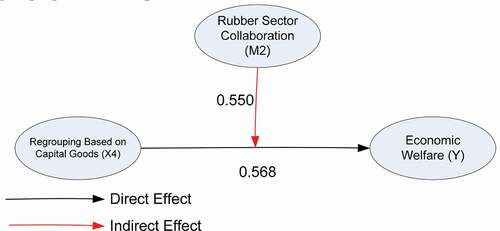
GSCA analysis obtained an interaction coefficient of 0.550 and P of 0.000. <0.05 indicates that the Rubber Sector Collaboration is a moderator variable between the effect of Regrouping Based on Capital Goods (X4) on Economic Welfare (Y). Because the direct influence and the effect of interaction are equally significant for company performance (Y), the Rubber Sector Collaboration variable is a quasi-moderator. While the coefficient of interaction effect is positive, the Collaborative Rubber Sector (M) variable is reinforcing. Higher Rubber Sector Collaboration (M), increases the influence of Regrouping Based on Capital Goods (X4) on Economic Welfare (Y). .
7.1. Discussion
Analysis result indicated that Economic Institutional Based Community had an effect on Economic Welfare. A high Institutional Based Community Economic will have an impact on the high Economic Welfare. The direction expected from this economic informal institution is about how the newly formed informal institutions can play an active role in the rubber auction process which has been dominated by the Tauke and Joint Business Group (KUB). The output of the model offered for the short term is the realization of a community-based economic institution (based on capital owned) by making the rubber plantation community a pioneer (agent of change). At the next level, the new institution that has been formed is directed to be able to participate in the rubber auction system. The outcome to be achieved is the economic stability of the community as this is sought by the community (pragmatism mindset). Furthermore, at the mid-term level, this study concludes the importance of optimizing the function and role of formal institutions in the management locus of rubber commodities in Kuantan Singingi Regency as the rubber management in Kuantan Singingi is inadequate. There is a lack of coordination of authorized formal stakeholders and a grand design on a long-term basis. Therefore, when it comes to creating a rubber downstream business in Riau, it is absolutely necessary to have new rubber land that is more conducive and productive both in the environmental and socio-economic perspectives of the community.
Furthermore, this study also found that the Social Network Establishment had an effect on Economic Welfare. A high social network establishment will have an impact on the high economic welfare. The potential development of social networks is between rubber plantation communities and (especially) rubber processing companies and the Office of Industry and Trade of Kuantan Singingi Regency. In the context of social networking, it is also necessary to carry out strengthening of social networks, especially with the Office of Plantation in order to increase effectiveness and efficiency by providing rubber seeds. The development and strengthening of this social network will later be related to the immediate term stages in the form of strengthening the functions and roles of the formal institutions are also recommended in this study
Re-trust of Social Affiliation has an effect on Economic Welfare. The high Re-trust of Social Affiliation will have an impact on the high economic welfare. The findings in the field indicate that in terms of a trust, the rubber plantation community in Kuantan Singingi was degraded after a rubber cooperative manager embezzled a certain amount of members’ capital. This incident caused rubber farmers no longer believe in the presence of socio-economic institutions, which were based on cooperative systems. On the other hand, when it comes to developing social capital-based institutions, trust factors play a vital role. When the trust factor has been obtained, despite plummeting rubber price, it remained a mainstay of the community because the big name of Kuantan Singingi rubber has become popular. This is a form of positive capital not easy to build on national and international markets. Nevertheless, it remained that how the “human” or the rubber processing community itself maintain Kuantan Singingi rubber reputation.
The Regrouping Based on Capital Goods has an effect on Economic Welfare. The high Regrouping Based on Capital Goods will have an impact on the high economic welfare. The urgency of re-grouping rubber plantation communities is due to the diversity of capital goods ownership from the rubber plantation community itself. The results of the study exhibited that the general pattern found in the ownership structure of community capital exhibits that most rubber processing communities possess other capital. Capital goods ownership variations in the community structure of the Kuantan Singingi rubber plantation are as follows: (a) rubber and palm oil; (b) rubber and PETI (unauthorized mining); (c) rubber and cattle; (d) rubber, cattle, and palm oil. By conducting re-grouping, it is expected that the people who initially have managed rubber will prevail using rubber commodity itself without having to hinder or prohibit them from managing/processing other commodities (livestock, PETI, and palm).
The influence of Rubber Sector Coordination and the Rubber Sector Collaboration on Economic Welfare. High Rubber Sector Coordination and Collaboration have an impact on the high Economic Welfare. On the other hand, the moderating effect of the Rubber Sector Coordination (M1) and the Rubber Sector Collaboration (M2) was also moderated and strengthened the influence of the variable Institutional Based Community (X1), Social Network Establishment (X2), Re-trust of Social Affiliates (X3), and Regrouping Based on Capital Goods (X4) on Economic Welfare (Y).
8. Conclusions and recommendations
Based on the results of the analysis, there is the influence of Society-Based Economic Institutions (X1), Social Networking (X2), Social Affiliation Trust (X3), and Capital Goods-Based Grouping (X4) and Rubber. Field Coordination (M1) and Rubber Sector Collaboration (M2) for Economic Welfare (Y). The higher the value of Community-Based Economic Institutions (X1), Social Networking (X2), Social Affiliation Trust (X3), and Capital Goods-Based Grouping (X4) and Rubber Sector Coordination (M1) and Collaboration in the Rubber Sector (M2) will have an impact on increasing economic welfare (Y). Also, it was found that the Rubber Sector Coordination and Collaboration moderated the influence of the variables of Society-Based Economic Institutions (X1), Social Networking (X2), Social Affiliation Trust (X3), and Quasi Regrouping Based on Moderators and Enrichment of Capital Goods (X4).
The results of this study provide support for the concepts offered by the Theory of Trust. If the application of this theory has been proven to apply to many public sector organizations in several countries, the results of this study provide additional understanding of its reliability to be applied to professional organizations in the mid-level rubber cultivation sector. Theoretically, the research results have implications for the development of social theory concepts, beliefs, and economic theories, particularly in public sector organizations. The results showed the domination of the influence of Community-Based Economic Institutions over other variables on the economic welfare of the community at the Rubber Plantation in Kuantan Singingi Regency which can be used as input and consideration for regulators (government) and the community in improving institutions. aspects of yield and efficiency of rubber production.
Based on the results of the study, it is suggested to increase the community’s trust in rubber plantations to existing and/or established social institutions. If the trust aspect has been able to be returned to a better level, the next step is to build a joint commitment to the rubber sector in Kuantan Singingi. It must be maintained and enhanced both qualitatively and quantitatively. Furthermore, strengthening the awareness and ownership of the rubber plantation community on the existence of Kuantan Singingi rubber. This is considered important because the current trend for people to be indifferent and leave the rubber sector is simply due to a lack of innovation. On the other hand, it is necessary to take steps to integrate or collaborate rubber commodities with other commodities that have been “glimpsed” by the rubber plantation community in Kuantan Singingi. This study also recommends the need for a grand design related to land reclamation to increase the area of rubber land in Kuantan Singingi. This of course requires support from the central government level.
Likewise, to improve economic welfare, both the community and the government should increase the value aspects of the Community-Based Economic Institutions, Social Networking, Social Affiliation Trust, and Capital Goods-Based Grouping and Rubber Sector Coordination and Collaboration in the Rubber Sector with the hope of greater economic welfare good for the future.
Additional information
Funding
Notes on contributors

Sujianto Sujianto
Sujianto is a Professor of Public Policy Science at the University of Riau, Indonesia. Sujianto was born in Tembilahan, on 26 September 1962. He is currently a lecturer in the Department of Public Administration at the University of Riau. Sujianto took his last doctoral education at the National University of Malaysia in the field of Local Institutions Implementation. Currently, he has many publications both on a national and international scale.
References
- Adi, I. R. (2008). Community intervention: Community development as community empowerment efforts. Rajawali Press.
- Coleman, J. S. (1988). Social capital in the creation of human capital. The American Journal of Sociology, 94(1), 95–15. https://doi.org/https://doi.org/10.1086/228943
- Cottrell, N. B., & Epley, S. W. (1977). Affiliation, social comparison, and socially mediated stress reduction. In J. M. Suls & R. L. Miller (Eds.), Social comparison processes (pp. 43–68). Halsted Press.
- Delelis, G. (2002). Emotions et interactions sociales. L’affiliation et l’isolement comme modes de régulation personnelle et sociale [Emotions and social interactions. Affiliation and isolation as modes of personal and social regulation]. Unpublished PhD Thesis. France: University of Lille 3.
- Field, J. (2005). Social capital and lifelong learning. Policy Press.
- Hikmat. (2006) . Community empowerment in development. Jurnal Perekonomian dan Kawasan Ekonomi Asia.
- Kulik, J. A., & Mahler, H. I. M. (2000). Social comparison, affiliation, and emotional contagion under threat. In J. M. Suls & L. Wheeler (Eds.), Handbook of social comparison: Theory and research (pp. 295–320). Kluwer Academic/Plenum.
- Nasdian, F. T. (2014). Community development. Indonesian Torch Library Foundation.
- Nurhadi. (2008). Social Capital Translation. Kreasi Wacana.
- Schachter, S. (1959). The psychology of affiliation. Experimental studies of the sources of gregariousness. Stanford University Press.
- Solimun. (2012). Generalized structured component analysis GSCA structural modeling Presented in the multivariate statistics application training: GSCA at the faculty of mathematics and natural sciences.Malang: Brawijaya University.
- Statistics, C. B. (2013). Riau in Figures 2013. BPS Provinsi Riau, Pekanbaru.
- Sujianto. (2008) . Public policy implementation, concepts, theories, and practices. Pekanbaru. Alaf Riau.

